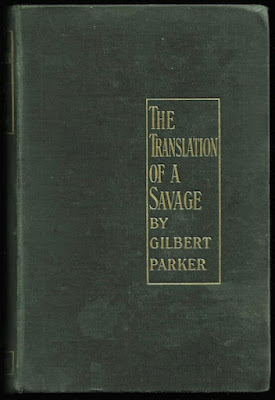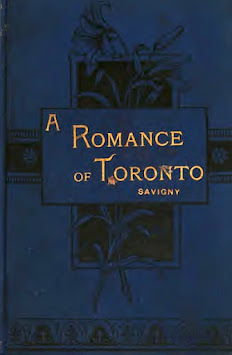New York: Wessels, 1906
276 pages
The Heart of the Ancient Wood unfolds so very, very slowly with descriptions of the wood, its creatures, their sounds, their scents, their habits, their habitats, the trees, the sky, and the air until a "grey man figure" appears. The cock-partridge, the nuthatch, the bear, the wild-cat, and the weasel all react differently. The wood-mice quiver with fear, while the hare looks on with "aversion, not unmixed with scorn" while noting the man's lumbering gait:
“Never,” thought the hare, disdainfully, "would he be able to escape from his enemies!”
The man figure's name is David "Old Dave" Titus. He has come to prepare the cabin. But for what purpose?
The answer comes in the third chapter, "The Exiles from the Settlement," with the arrival of Kirstie Craig (née MacAlister) and her young daughter Miranda, as announced by "the dull tanky tank, a-tonk, tank of cowbells." The pace picks up with Kirstie's backstory. A "tall, erect, strong-stepping, long-limbed woman," she'd lived her entire life in a place identified only as "the Settlement." Some seven years earlier Kirstie had chanced to be in a store when in walked a man unlike any other she had ever seen. This was Frank Craig, dilettante, musician, poet, and artist ("when the mood seized him strongly enough"). A prime specimen of a fish out of water, Frank had been advised to forgo city life for the restorative nature of country air.
Before he had breathed it a month he had won Kirstie MacAlister, to whom he seemed little less than a god. To him, on her part, she was a splendid mystery. Even her peculiarities of grammar and accent did no more than lend a piquancy to her strangeness. They appealed as a rough, fresh flavour to his wearied senses.
Theirs seemed an ideal marriage, and maybe it was, but there came a time when Frank became restless. He talked about business in "the city" (also unidentified) that needed attending to. Kirstie saw her husband off on a rattling mail-wagon. The next paragraph is my favourite in the entire novel:
But – he never came back. The months rolled by, and no word came of him; and Kirstie gnawed her heart out in proud anguish. Inquiry throughout the cities of the coast brought no hint of him. Then, as the months climbed into years, that tender humanity which resents misfortune as a crime started a rumour that Kirstie had been fooled. Perhaps there had been no marriage, went the whisper at first. “Served her right, with her airs, thinkin’ she could ketch a gentleman!” – was the next development of it. Kirstie, with her superior air, had never been popular at best; and after her marriage the sufficiency and exclusiveness of her joy, coupled with the comparative fineness of speech which she adopted, made her the object of jealous criticism through all the country-side. When the temple of her soaring happiness came down about her ears, then was the time for her chastening, and the gossips of the Settlement took a hand in it with right good-will. Nothing else worth talking about happened in that neighbourhood during the next few years, so the little rumour was cherished and nourished. Presently it grew to a great scandal, and the gossips came to persuade themselves that things had not been as they should be. Kirstie, they said, was being very properly punished by Providence, and it was well to show that they, chaste souls, stood on the side of Providence. If Providence threw a stone, it was surely their place to throw three.
Some one else had heard from some one else of some one having seen Frank Craig in the city. There was at first a difference of opinion as to what city; but that little discrepancy was soon smoothed out. Then a woman was suggested, and forthwith it appeared that he had been seen driving with a handsome woman, behind a spanking pair, with liveried coachman and footman on the box.Sadly, these elements and all their intrigue vanish completely, leaving the reader with more purple prose and a near absence of plot.
So as to escape bitter tongues, Kirstie makes a home for herself and little Miranda in the cabin. It's a rather idyllic if modest existence with remarkably few challenges. Good ol' Old Dave, Kirstie's only friend, drops by on occasion; otherwise the only human contact mother and daughter have is with each other. Miranda becomes an object of curiosity to the woodland creatures and is curious in return. The girl's main focus is a female bear, "far the most human of all the furry woodfolk," that her young mind identifies as a "nice, big dog." There is a chance encounter early in the novel, after which Kirstie insists the girl stay within sight of the cabin.
Kirstie and Miranda survive their first winter at the cabin without difficulty, aided in part by an early spring. The bear emerges from hibernation and a few days later gives birth to a male cub. He's so very weak, but under his mother's care the cub becomes the most playful, curious, and cute of little guys before being crushed by a hunter's trap. That same awful day, the grieving she-bear comes upon Miranda as the girl is about to be set upon by a panther. The bear saves the girl and escorts her back to the cabin. Kirstie is rightfully wary, yet comes recognize the bear, Kroof, as a protector and companion. As Miranda grows into adulthood, she becomes at one with the creatures of the ancient wood, and they in turn grow to both trust her and accept her as their superior. This includes the panther.
One afternoon, Miranda comes upon a young man sleeping beneath a tree. In an echo of the scene years earlier involving Kroof, a panther is about to spring. As a student of Kroof, Miranda manages to order it away. The young man turns out to be Young Dave, son of Old Dave. The two haven't seen each other since the day Craig mother and daughter left the Settlement. Young Dave is immediately taken with the mature Miranda and soon becomes a frequent visitor. Kirstie likes Young Dave, but her daughter runs lukewarm and cold. Her reaction has something to do with the fact that the young man is a hunter, where she and her mother are vegetarians. I'd suggest it also has something to do with Miranda being unaccustomed to people, never mind a man who is more or less her own age.
Young Dave pitches woo, but to no avail. He goes so far as to take Miranda on an excursion away from the cabin, deftly navigating dangerous rapids in order to deliver much needed medicine to a young mother and her ailing son. If anything, the visit pushes Miranda farther away, though this has to do with the older woman's assumption that the girl is Dave's fiancée.
A fair percentage of the closing chapters involves play between the two with Young Dave doing his best to ingratiate himself and making a bit of progress only to be pushed away.
Will they or won't they?
As with sitcoms, the question is increasingly tiring with each passing year. The resolution was not one I saw coming. You'd think I would've remembered.
What happens is that Young Dave is walking through the ancient wood one day on yet another visit to the cabin when he chances upon a small male bear cub. He kills the cub with a shot to the head, skins it, cuts out the choicest portions, and continues on his merry way.
To this point, Young Dave has been portrayed as quick and intelligent. He's met Kroof many a time with Miranda over the years, is aware of the unusual relationship they share, and knows there are no other bears in the area. And yet, and yet, and yet, he kills without so much as a thought that the cub just might be the Kroof's.
Kroof finds what's left of her son, a red carcass "hideously affronting the sunlight, "walks around it twice, and then sets off on Dave's trail:
She was not blinded by her fury. Rather was she coolly and deliberately set upon a sufficing vengeance. She moderated her pace, and went softly; and soon she caught sight of her quarry some way ahead, striding swiftly down the brown-shadowed vistas. There was no other bear in all the forests so shrewd as Kroof.She catches up with Dave as he's washing in a small steam so as to make himself presentable to Kirstie and Miranda. The hunter makes for a beech tree and begins climbing with the bear following. Miranda arrives on the scene and tries to call Kroof off. In desperation, she picks up Dave's rifle and fires:
The bear’s body heaved convulsively for a moment, then seemed to fall together on the branch, clutching at it. A second later and it rolled off, with a leisurely motion, and came plunging downward, soft, massive, enormous. It struck the ground with a sobbing thud. Miranda gave a low cry at the sound, turned away, and leaned against the trunk of the hemlock. Her face was toward the tree, and hidden in the bend of her arm.Have we had enough?
The very next sentence is the worst:
Dave knew now that all he had hoped for was his.I will not be reading this novel a third time.
Personal note: In the midst of reading The Heart of the Ancient Wood, I stumbled upon this beautiful poster.
Good thing I put off the purchase for a couple of days. Knowing her fate, how could I put that image of Kroof on my wall.
Object and Access: A later edition, my copy was purchased for $2.50 sometime in the early 'eighties at Montreal's Russell Books. It's title page makes a big deal of it being illustrated, but the only illustration appears on the frontispiece. The first edition, published in 1900 by Silver, Burdett & Co, features a total of six, including the one found in my Wessels edition. All are by English-born James Weston (1841-1922), a man remembered more for his landscapes than his book illustrations. Looking at those he provided for this novel, I can see why, though I am partial to this:
The Heart of the Ancient Wood first appeared – in its entirety – in the April 1900 issue of Lippincott's Magazine. The novel has enjoyed numerous editions through the decades and as number 110 was once a New Canadian Library staple. It's currently available only as part of the Formac Fiction Treasures series.
The novel has enjoyed a Polish translation (Vsrdci pralesa, 1925).
Black panthers are not native to Canada.


























































